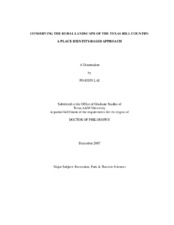| dc.contributor.advisor | Shafer, C. Scott | |
| dc.creator | Lai, Po-Hsin | |
| dc.date.accessioned | 2010-01-15T00:08:07Z | |
| dc.date.accessioned | 2010-01-16T00:43:42Z | |
| dc.date.available | 2010-01-15T00:08:07Z | |
| dc.date.available | 2010-01-16T00:43:42Z | |
| dc.date.created | 2007-12 | |
| dc.date.issued | 2009-05-15 | |
| dc.identifier.uri | https://hdl.handle.net/1969.1/ETD-TAMU-2595 | |
| dc.description.abstract | Landscape change induced by population growth and urban development is
impacting the ecosystem goods and services provided by open space, which is essential
to supporting many urban and rural populations. Conserving open space cannot be
attained without obtaining public support especially in a state like Texas where most
open space is privately owned. This dissertation was aimed at exploring the role of place
identity as an intrinsic incentive for landowner involvement in conserving open space
threatened by landscape change. Four objectives addressed in this research include: 1)
defining place identity and identifying its underlying dimensions; 2) developing and
refining a place-identity scale; 3) developing and testing a conceptual framework to
explain the relationships among commitment, place identity, behavior/behavioral
intention to manifest place identity, and perception of landscape change; and 4) drawing
implications for open space conservation. Identity theory and identity control theory
were applied to conceptualize place identity and develope structural models for
hypothesis testing. Place identity was defined as comprising meanings that individuals
ascribe to a place through their interaction with that place and become defining elements
of their self-identity. Both qualitative and quantitative methods were used in this
research. Results from semi-structured interviews with a convenience sample of
landowners in the Texas Hill Country were used to develop the place-identity scale.
Survey data from randomly selected Hill Country landowners were used in confirmatory
factor analysis, mean and covariance structure analysis, and invariance testing based on the covariance structure to test and refine measures, to compare differences between
landowner groups, and to test hypotheses. Findings suggested that identity theory and
identity control theory provided valuable insight to place identity in the face of change.
Results also supported a model of place identity comprised of cognitive and affective
dimensions, and identified variations among individuals in their affective place-identity.
Moreover, findings indicated that both dimensions exhibited different effects on
identity-related behavior/behavioral intention under the influence of landscape change.
Implications were provided for engaging landowners in open space conservation. This
dissertation addresses several research gaps, and also raises questions important in
understanding and applying place identity to promoting conservation. | en |
| dc.format.medium | electronic | en |
| dc.format.mimetype | application/pdf | |
| dc.language.iso | en_US | |
| dc.subject | place identity | en |
| dc.subject | landscape change | en |
| dc.subject | open space conservation | en |
| dc.subject | landowner | en |
| dc.subject | Hill Country | en |
| dc.title | Conserving the rural landscape of the texas hill country: a place identity-based approach | en |
| dc.type | Book | en |
| dc.type | Thesis | en |
| thesis.degree.department | Recreation, Park, and Tourism Sciences | en |
| thesis.degree.discipline | Recreation, Park, and Tourism Sciences | en |
| thesis.degree.grantor | Texas A&M University | en |
| thesis.degree.name | Doctor of Philosophy | en |
| thesis.degree.level | Doctoral | en |
| dc.contributor.committeeMember | Kreuter, Urs P. | |
| dc.contributor.committeeMember | Kyle, Gerard | |
| dc.contributor.committeeMember | Nepal, Sanjay K. | |
| dc.contributor.committeeMember | Sell, Jane A. | |
| dc.type.genre | Electronic Dissertation | en |
| dc.type.material | text | en |
| dc.format.digitalOrigin | born digital | en |


